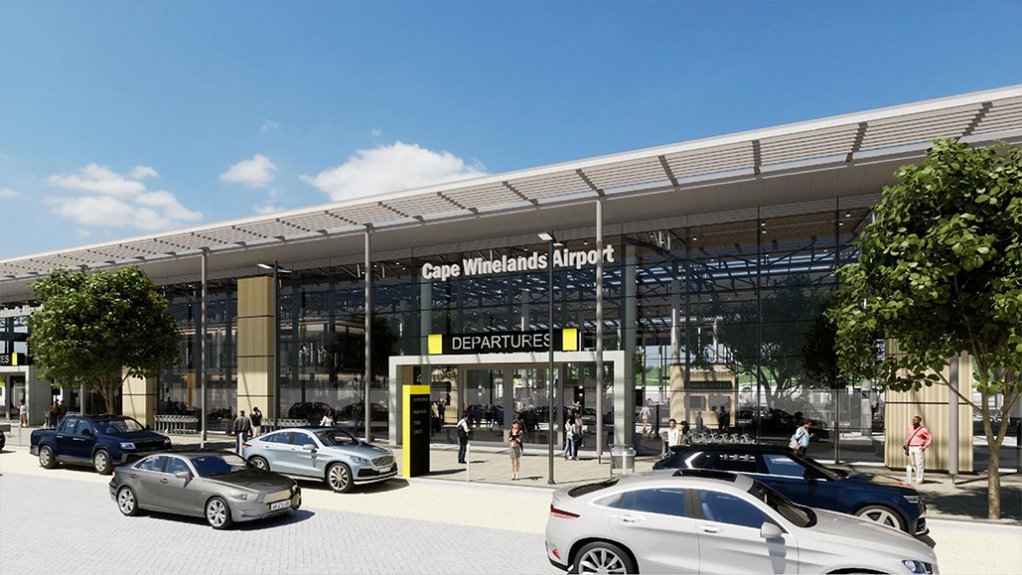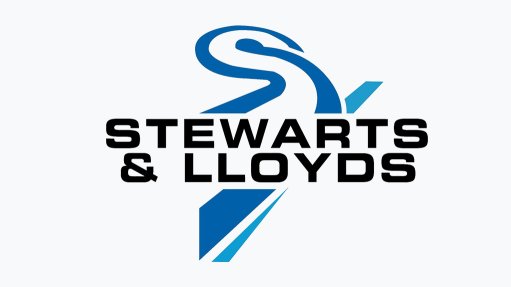Multibillion-rand Cape Winelands Airport aims to receive first passengers in 2027
Cape Town’s proposed second big commercial airport, the Cape Winelands Airport (CWA), should receive its first passengers in 2027, says RSA.Aero MD Nick Ferguson.
RSA.Aero is the project developer, with the first phase expected to cost between R5-billion and R7-billion.
Phase 1 will include a 3.5 km runway, taxiways, the terminal building and road infrastructure.
The airport will be located in Durbanville, on the northern outskirts of Cape Town.
CWA’s customers are expected to come from Cape Town, as well as the nearby Stellenbosch, Paarl, Wellington and the West Coast.
CWA will be partially built on the site of the current 155 ha Fisantekraal Airport, a private airport handling mainly general aviation.
This facility was built in 1943 by the Allied Forces to protect the South African coastline during World War Two.
The new development will see the site expand to 450 ha in Phase 1, in a northerly direction, and, ultimately, potentially, to the full 884 ha owned by RSA.Aero.
“We’ll expand incrementally and in line with demand,” Ferguson tells Engineering News Online. “But the aim is to add hotels, cargo facilities, aeroplane maintenance sites, a conference centre and much more.”
“People always ask if CWA will be like the privately owned Lanseria, in Johannesburg,” he adds.
“The answer is yes, but it will be bigger, with a longer runway that can accommodate wide-body aeroplanes – which means it will be able to handle more international traffic, from more destinations, compared with Lanseria.”
RSA.Aero has already started the environmental impact assessment on the project.
Ferguson aims to have this finished by early next year, with construction to start once the project has been given the green light.
Construction will take approximately two years, with the first scheduled traffic set to land in 2027.
Ferguson is upbeat about the airport’s potential, as Cape Town International Airport (CTIA) cannot currently accommodate A380s – the world largest commercial passenger aircraft and the largest contingent in the Emirates fleet, for example.
Also: “Johannesburg is mainly a transit hub for most tourists. They land there and immediately fly on to other destinations. If Cape Town is their final destination, then why not fly there directly?”
CTIA is owned and operated by State-owned Airports Company South Africa (ACSA).
Does this not place the privately owned CWA in direct competition with CTIA?
Yes, admits Ferguson, but all major world-class cities have more than one airport.
“Look at London, New York and Sydney – even our neighbour Windhoek has two airports.”
While the current Fisantekraal site is licensed as an airport, this licence will have to be expanded for the airport to handle bigger aircraft and more traffic.
It also has to be classified as a designated airport, which will allow it to handle scheduled traffic.
This process is mainly centred around airport security.
“This means that if we achieve the desired milestones, we’ll get this licence,” says Ferguson.
The more challenging matter will be an application to the national Department of Transport (DoT) for the site be licensed as an international airport.
“This immediately means that the Border Management Authority becomes involved, and if you do not have buy-in here, you’ll struggle to clear this hurdle,” says Ferguson.
“But, we believe we can show national government the immense value of building the Winelands airport, especially to international carriers and the environment.
“We already have the written support of the City of Cape Town and the Western Cape government.”
Ferguson says RSA.Aero is in the process of handing in its international licence application to the DoT.
Heavy Hitters
RSA.Aero is certainly not short on experience and knowledge to succeed in its licence application, as it has some heavy hitters on its board and within management.
Th Cape Winelands Airport project MD is Deon Cloete, former ACSA CTIA GM from 2008 to 2021.
The RSA.Aero board of directors include former ACSA CEO Dirk Ackerman (chairperson); former ACSA CEO Monhla Hlahla; FlySafair chairperson Blacky Komani, who is also Tourism Business Council of South Africa chairperson; as well as the former head of the South African Air Force, Fabian Msimang.
Private investor and outspoken ANC-government critic Rob Hersov is no longer involved in the project, says Ferguson.
He adds that the company has secured commitments from a number of airlines to fly to CWA once it is operational.
He says RSA.Aero aims to secure an international airline, most probably from the Middle East, as its anchor airline, offering it naming rights and exclusivity for a certain period in return.
Domestic airlines are also in the crosshairs, with the Cape Town – Johannesburg route “the tenth busiest in the world”.
Ferguson says CTIA is currently handling 10-million passengers a year, with the Cape Town market set to go to 20-million passengers a year by 2050.
“We hope to welcome two-million passengers a year at CWA by 2030, and five-million by 2050.
“This means CTIA will still have 15-million passengers a year by 2050, but with CWA to attract one in every two new passengers.”
How an Airport Can Exist With No Traffic
One prominent reason for building the CWA would be for the facility to act as an alternate airport to CTIA, notes Ferguson.
This designation will also serve as one of the airport’s main funding sources.
“Any airplane that takes to the skies must lodge a flight plan saying where it is going, how many passengers it is carrying, and how much fuel it is carrying.
“This flight plan must also designate an alternate destination airport in case of an emergency. In other words, if there is a problem at the intended destination, where will we land?”
While this is an easier matter for a small plane, as there are numerous small airfields dotted across the country, this has proved to be a headache for larger planes flying into Cape Town, says Ferguson.
“A Boeing 777 cannot land in George. If you look at the big international carriers, most of them have to turn back to Johannesburg in case of an emergency or severe weather – this the same distance as London to Berlin.”
It also means that these planes have to carry the extra fuel they require to make the return trip to Johannesburg.
“A 777 will carry ten tons of extra fuel to divert,” says Ferguson. “This also makes it heavier, which means it burns more fuel – so the plane is burning four tons of the ten, just to carry it”.
“What is more, is that the cost of the extra fuel burned by an airline is roughly R100 000 per flight. And, if the plane didn’t have to carry that fuel, it could have carried ten tons of cargo, earning them about R1.5-million in revenue.
“So, what we are saying – and we are applying it to domestic airlines as well – is that we’ll build CWA, but then RSA.Aero will share in the value creation of having this extra airport in Cape Town.
“In other words, airlines share a portion of the value that is created with CWA, and this allows us to build the airport.
“We believe our existence will save the industry about R1.2-billion a year, with us then taking a reasonable share of this to fund the construction of the airport,” notes Ferguson.
“This is science,” he adds, “not speculation. Pace Labs in Germany did the modelling for this proposal, using different aircraft and routes.
“If using 2019 traffic numbers, having CWA as an alternate airport means that airlines can carry 110 t in extra cargo to the city a year, while reducing their fuel consumption by 23-million litres, saving 60-million kilogrammes of carbon dioxide a year.”
Ferguson also notes that CWA will aim to be the greenest airport in the world, as it will be off-grid in terms of water, sanitation and electricity provision.
Article Enquiry
Email Article
Save Article
Feedback
To advertise email advertising@creamermedia.co.za or click here
Comments
Press Office
Announcements
What's On
Subscribe to improve your user experience...
Option 1 (equivalent of R125 a month):
Receive a weekly copy of Creamer Media's Engineering News & Mining Weekly magazine
(print copy for those in South Africa and e-magazine for those outside of South Africa)
Receive daily email newsletters
Access to full search results
Access archive of magazine back copies
Access to Projects in Progress
Access to ONE Research Report of your choice in PDF format
Option 2 (equivalent of R375 a month):
All benefits from Option 1
PLUS
Access to Creamer Media's Research Channel Africa for ALL Research Reports, in PDF format, on various industrial and mining sectors
including Electricity; Water; Energy Transition; Hydrogen; Roads, Rail and Ports; Coal; Gold; Platinum; Battery Metals; etc.
Already a subscriber?
Forgotten your password?
Receive weekly copy of Creamer Media's Engineering News & Mining Weekly magazine (print copy for those in South Africa and e-magazine for those outside of South Africa)
➕
Recieve daily email newsletters
➕
Access to full search results
➕
Access archive of magazine back copies
➕
Access to Projects in Progress
➕
Access to ONE Research Report of your choice in PDF format
RESEARCH CHANNEL AFRICA
R4500 (equivalent of R375 a month)
SUBSCRIBEAll benefits from Option 1
➕
Access to Creamer Media's Research Channel Africa for ALL Research Reports on various industrial and mining sectors, in PDF format, including on:
Electricity
➕
Water
➕
Energy Transition
➕
Hydrogen
➕
Roads, Rail and Ports
➕
Coal
➕
Gold
➕
Platinum
➕
Battery Metals
➕
etc.
Receive all benefits from Option 1 or Option 2 delivered to numerous people at your company
➕
Multiple User names and Passwords for simultaneous log-ins
➕
Intranet integration access to all in your organisation





















